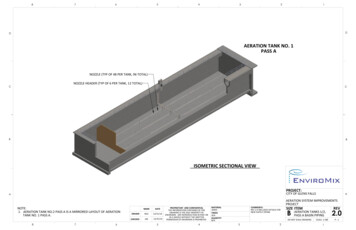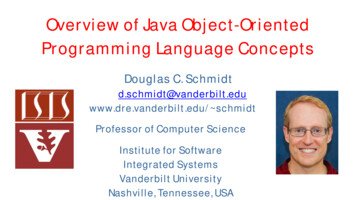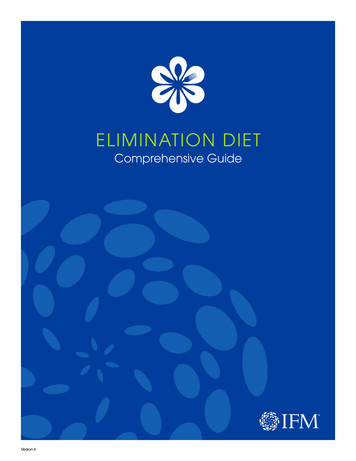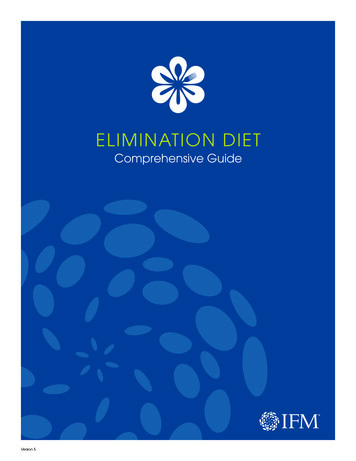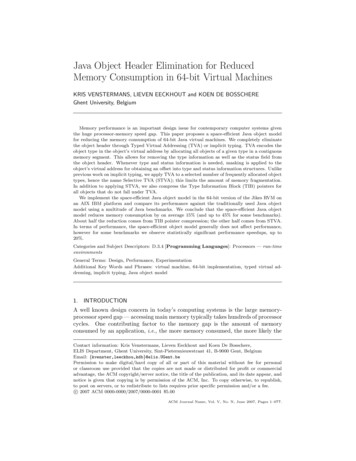
Transcription
Java Object Header Elimination for ReducedMemory Consumption in 64-bit Virtual MachinesKRIS VENSTERMANS, LIEVEN EECKHOUT and KOEN DE BOSSCHEREGhent University, BelgiumMemory performance is an important design issue for contemporary computer systems giventhe huge processor-memory speed gap. This paper proposes a space-efficient Java object modelfor reducing the memory consumption of 64-bit Java virtual machines. We completely eliminatethe object header through Typed Virtual Addressing (TVA) or implicit typing. TVA encodes theobject type in the object’s virtual address by allocating all objects of a given type in a contiguousmemory segment. This allows for removing the type information as well as the status field fromthe object header. Whenever type and status information is needed, masking is applied to theobject’s virtual address for obtaining an offset into type and status information structures. Unlikeprevious work on implicit typing, we apply TVA to a selected number of frequently allocated objecttypes, hence the name Selective TVA (STVA); this limits the amount of memory fragmentation.In addition to applying STVA, we also compress the Type Information Block (TIB) pointers forall objects that do not fall under TVA.We implement the space-efficient Java object model in the 64-bit version of the Jikes RVM onan AIX IBM platform and compare its performance against the traditionally used Java objectmodel using a multitude of Java benchmarks. We conclude that the space-efficient Java objectmodel reduces memory consumption by on average 15% (and up to 45% for some benchmarks).About half the reduction comes from TIB pointer compression; the other half comes from STVA.In terms of performance, the space-efficient object model generally does not affect performance,however for some benchmarks we observe statistically significant performance speedups, up to20%.Categories and Subject Descriptors: D.3.4 [Programming Languages]: Processors — run-timeenvironmentsGeneral Terms: Design, Performance, ExperimentationAdditional Key Words and Phrases: virtual machine, 64-bit implementation, typed virtual addressing, implicit typing, Java object model1. INTRODUCTIONA well known design concern in today’s computing systems is the large memoryprocessor speed gap — accessing main memory typically takes hundreds of processorcycles. One contributing factor to the memory gap is the amount of memoryconsumed by an application, i.e., the more memory consumed, the more likely theContact information: Kris Venstermans, Lieven Eeckhout and Koen De Bosschere,ELIS Department, Ghent University, Sint-Pietersnieuwstraat 41, B-9000 Gent, BelgiumEmail: {kvenster,leeckhou,kdb}@elis.UGent.bePermission to make digital/hard copy of all or part of this material without fee for personalor classroom use provided that the copies are not made or distributed for profit or commercialadvantage, the ACM copyright/server notice, the title of the publication, and its date appear, andnotice is given that copying is by permission of the ACM, Inc. To copy otherwise, to republish,to post on servers, or to redistribute to lists requires prior specific permission and/or a fee.c 2007 ACM 0000-0000/2007/0000-0001 5.00ACM Journal Name, Vol. V, No. N, June 2007, Pages 1–0?.
2·data will not fit into the processor’s cache hierarchy, the more likely the applicationwill have to access main memory. This is an important issue for 64-bit Java VMimplementations. A recent study by Venstermans et al. [2006a] quantified thatobjects are nearly 40% larger in a 64-bit VM compared to a 32-bit VM. And abouthalf this increase is due to the object header doubling in size.This paper focuses on reducing the memory consumption of 64-bit Java VMimplementations. Our approach to reducing the memory consumption of a 64bit VM is to completely eliminate the object header. This is done through TypedVirtual Addressing (TVA) which means that the object type information is encodedin the object’s virtual address, i.e., all objects of the same type are mapped to thesame contiguous memory segment. TVA enables to remove the Type InformationBlock (TIB) pointer field as well as the status field from the object header. Assuch, we are able to completely eliminate the 16 byte object header for non-arrayobjects; for array objects, we only keep the 4 byte array length field. Accessing theTIB is then done by masking a number of bits from the object’s virtual address,and using that as an offset in the TIB space that holds all the TIBs. Removingthe status field from the object header is done by keeping GC bits and hash bits —1 byte per object in our implementation — in so called side arrays. Our proposaldoes not apply TVA to all object types but only to a selected number of types thatare frequently allocated, hence the name Selective TVA (STVA). The reason is thatapplying TVA to all object types would result in too much memory fragmentationbecause of memory pages being sparsely filled with only a few objects.The idea of typed addressing or implicit typing is not new. Typed addressinghas been proposed in the past with proposals such as Big Bag of Pages (BiBOP),typed pointers and others [Appel 1989; Dybvig et al. 1994; Hanson 1980; Shebs andKessler 1987; Steele, Jr. 1997]. In fact, it was fairly popular in the 1970s, 1980sand early 1990s in various functional and logic programming languages. However,typed addressing has fallen into disfavor from then on because of the fact that all ofthese proposals applied typed addressing for all object types. As mentioned above,applying typed addressing to all objects results in memory fragmentation, and eventually performance degradation. With the advent of 64-bit Java implementations,a well designed typed virtual addressing mechanism becomes an interesting optionfor reducing the memory consumption of 64-bit Java VMs because the 64-bit virtual address space is huge which facilitates the implementation of implicit typingcompared to 32-bit platforms.In addition to removing the header for all TVA-enabled objects, we also compressthe 64-bit TIB pointers to 32-bit pointers for all TVA-disabled objects. Previouswork [Adl-Tabatabai et al. 2004] proposed pointer compression to all pointers (notjust TIB pointers) in a 64-bit VM implementation. However, the limitation ofcompressing all pointers is that applications that require more than a 32-bit virtualaddress space cannot benefit from this pointer compression approach. Applyingpointer compression to TIB pointers only does not suffer from this limitation; thecase where more than a 32-bit virtual address space is needed for type informationis highly unlikely.We implement our space-efficient header approach in the 64-bit Jikes RVM andevaluate the reduction in memory consumption and the impact on performanceACM Journal Name, Vol. V, No. N, June 2007.
·3on an AIX IBM POWER4 system. (Previous work on typed addressing did notreport the impact on performance of typed addressing, and in most cases did noteven quantify the amount of reduction in memory consumption.) In addition, weapply statistics in order to make statistically valid conclusions. We conclude thatour space-efficient Java object model reduces memory consumption by on average15% (up to 45% for some benchmarks). On average, half the memory consumptionreduction comes from TIB pointer compression; the other half comes from STVA. Interms of performance, the space-efficient Java object model has a net zero impact onperformance for many benchmarks. For a small number of benchmarks we observea statistically significant degradation in performance by only a few percent (nomore than 5%). And for a number of other benchmarks we observe statisticallysignificant performance speedups, up to 20%. In general though, we conclude thatthe space-efficient Java object model substantially reduces memory consumptionwithout significantly affecting performance; however, performance improvementsare observed for some benchmarks.This paper extends our previous work [Venstermans et al. 2006b] by proposingan online STVA implementation; the prior work proposed an offline STVA implementation which required a profiling run to determine what objects to makeTVA-enabled. This paper also extends the prior work by showing how the complete header can be eliminated for TVA-enabled objects. The prior work reducedthe scalar object header from 16 bytes down to 4 bytes; the current work completelyeliminates the object header.2. THE 64-BIT JAVA OBJECT MODELThe object model is a key part in the implementation of an object-oriented languageand determines how an object is represented in memory. A key property of objectoriented languages is that objects have a run-time type. Virtual method calls allowfor selecting the appropriate method at run-time depending on the run-time typeof the object. The run-time type identifier for an object is typically a pointer to avirtual method table.An object in an object-oriented language consists of the object data fields alongwith a header. For clarity, we refer to an object as the object data plus the objectheader throughout the paper; the object data refers to the data fields only. Theobject header contains a number of fields for bookkeeping purposes. The objectheader fields and their layout depend on the programming language, the virtualmachine, etc. In this paper we assume Java objects and we use the Jikes RVM inour experiments. The object model that we present below is for the 64-bit JikesRVM, however, a similar structure will be observed in other virtual machines, orother object-oriented languages. An object header typically contains the followinginformation, see Figure 1(a):—The first field is the TIB pointer field, i.e., a pointer to the Type InformationBlock (TIB). The TIB holds information that applies to all objects of the sametype. In the Jikes RVM, the TIB is a structure that contains the virtual methodtable, a pointer to an object that represents the object type and a number ofother pointers for facilitating interface invocation and dynamic type checking.The TIB pointer is 8 bytes in size on a 64-bit platform.ACM Journal Name, Vol. V, No. N, June 2007.
4·(a) 64-bit Java object modelobject datastatus fieldTIB pointerforwarding pointer(b) shortening the TIB pointer for all objectsobject datastatus fieldTIB pointerforwarding pointer(c) eliminating the TIB pointer for TVA objectsobject datastatus fieldforwarding pointer(d) remapping the forwarding pointer for TVA objectsobject datastatus fieldforwarding pointer(e) eliminating the status field for TVA objectsobject dataforwarding pointerFig. 1.The Java (scalar) object models studied in this paper.—The second field is the status field. The status field can be further distinguishedin a number of elements.—The first element in the status field is the hash code. Each Java object has ahash code that remains constant throughout the program execution. Depending on the chosen implementation in the Jikes RVM, the hash code can be a10-bit hash field in the header or a 2-bit hash state.—The second element in the status field is the lock element which determineswhether the object is being locked. All objects contain such a lock element. Athin lock field [Bacon et al. 1998] in the Jikes RVM is 20 bits in size.—The third element is related to garbage collection. This could be a single bitthat is used for marking the object during a mark-and-sweep garbage collection.Or this could be a number of bits (typically two) for a copying or referencecounting garbage collector.—The third field is the forwarding pointer. The forwarding pointer is used forkeeping track of objects during generational or copying garbage collection andis 8 bytes in size. The forwarding pointer overwrites the hash code and lockelement in the status field, but not the garbage collection bits, see Figure 1(a).ACM Journal Name, Vol. V, No. N, June 2007.
·5The garbage collection bits are chosen as the least significant bits so that theydo not get overwritten by the forwarding pointer.So far, we considered non-array objects. For array objects there is an additional4 bytes length field that needs to be added to the object header. As a result,for array objects the header field requires at least 20 bytes. But given the factthat alignment usually requires objects to start on 8 byte boundaries on a 64-bitplatform, the array object header typically uses 24 bytes of storage.3. ELIMINATING THE HEADER IN THE 64-BIT JAVA OBJECT MODELWe eliminate the header of 64-bit Java objects in a number of steps. Our initialJava object model is the 16 byte header as shown in Figure 1(a) — we limit thediscussion to scalar objects for now, and will discuss array objects later.—We first reduce the TIB pointer size from 64-bit to 32-bit through pointer compression as proposed by [Adl-Tabatabai et al. 2004]. This is shown in Figure 1(b).This object model implies that all the TIBs are allocated in a contiguous virtualaddress space that is small enough to be accessed using a 32-bit offset. The TIBpointer is then computed by adding the 32-bit TIB pointer stored in the objectheader to a 64-bit TIB base pointer. TIB pointer compression is applied to allobjects.—As a second step we apply Selective Typed Virtual Addressing (STVA) to completely eliminate the TIB pointer from the object header, see Figure 1(c). STVAapplies Typed Virtual Addressing (TVA) to a selected number of object types.—In the third step, we map the forwarding pointer in a different way so that theforwarding pointer overlaps with the 4 byte status field and the first four bytesof the object data, see Figure 1(d). Note that the object data is already copiedduring garbage collection whenever the forwarding pointer gets used. As such,we can freely overwrite the first four bytes of the object data. (Obviously, thiscannot be done for data structures belonging to the garbage collector itself — thisis only of concern whenever the garbage collector (or the entire VM) is written inJava.) This layout requires to move the GC status bits from the least significantstatus field bit positions to the most significant status field bit positions so thatthe GC bits are not overwritten by the forwarding pointer.—As a final step, we remove the status field from the object header, see Figure 1(e).The end result is that the object header is completely eliminated for all TVAenabled objects.In the following sections, we discuss STVA in great detail since it is the keyenabler for completely eliminating the object header.4. SELECTIVE TYPED VIRTUAL ADDRESSINGThis section explains the idea and the implementation details behind SelectiveTyped Virtual Addressing (STVA) for 64-bit Java objects. We first detail on theTVA 64-bit Java scalar object model followed by the TVA array object model. Wethen go through a number of virtual machine implementation issues that followfrom the TVA object models.ACM Journal Name, Vol. V, No. N, June 2007.
6·4.1 The scalar TVA object modelWe consider two TVA Java object models: the small-header object model and theno-header object model.4.1.1 The small-header object model. The small-header TVA object model eliminates the TIB pointer from the object header and remaps the forwarding pointerto overwrite the 4 byte status field and the first 4 bytes of the object data, seeFigure 1(d). This implies that the minimum size occupied by a TVA-enabled object is 8 bytes: 4 bytes of object header and 4 bytes of data. We will refer to theobtained object model in Figure 1(d) as the small-header object model throughoutthe paper; this is the object model presented in our prior work [Venstermans et al.2006b].4.1.2 The no-header object model. The no-header object model extends on thesmall-header object model by eliminating the 4 byte status field, see Figure 1(e).This requires that we eliminate the lock, the hash and the GC elements, as well asthe forwarding pointer from the object header. This is done as follows.—We eliminate the GC elements from the object header by storing the GC elementsin what we call a side array. We implement a side array every two pages on whichTVA-enabled objects are allocated and allocate one byte per object in the sidearray. Note that depending on the garbage collector only one or two bits areused from the allocated byte in the side array. The position in the side arrayfor a given object is determined by the position of the object on the memorypage. Note that this can be done because all objects in a TVA region are of thesame type and thus are equally sized. By consequence, during garbage collection,we do not adjust the GC elements in the header for TVA-enabled objects butwe adjust the GC elements in the side arrays. The index in the side array iscomputed from the object’s virtual address which incurs an additional overheadcompared to the default and small-header object models.—Dealing with the lock element in the no-header format is done along what isdescribed in [Bacon et al. 2002]. Objects from a class that contains at leastone synchronized method (or at least one of the class methods contains thesynchronized(this) statement) have an additional implicit field member thatcontains the lock. This is a 4 bytes field in our implementation. This implicitlock field scheme cannot be applied to arrays or in cases where a lock is takingon an object. In these latter cases, a lock object is then created in the locknursery [Bacon et al. 2002].—The hash elements in the Java object model can take three states: unhashed,hashed and hashed-and-moved [Bacon et al. 2002; Agesen 1999]. For the firsttwo states, unhashed and hashed, the hash code is calculated from the object’saddress. In case the garbage collector moves an object that is in the hashed state,its state then changes to hashed-and-moved and the hash code is attached to theend of the new version of the object. In the traditional Java object model as wellas in the small-header object model, these three states are encoded using twohash bits. In the no-header object model on the other hand, we store only onebit per TVA-enabled object in the side arrays just described. The hash bit in theside array is zero if the object is unhashed; the hash bit in the side array is setACM Journal Name, Vol. V, No. N, June 2007.
·7if the object is hashed. When a hashed object is moved by the garbage collector,we TVA-disable the object, i.e., the object moves from the TVA space to thenon-TVA space.—The forwarding pointer, whenever needed during garbage collection, overwritesthe first 8 bytes of the object data. This implies that the minimum size for aTVA-enabled object is 8 bytes — this is the same as for the small-header objectmodel.4.2 The array TVA object modelThe array TVA object model more or less follows the same lines as the scalarTVA object model, however, there are some peculiarities in relation to memorymanagement. In case of a copying collector, the memory allocator typically uses abump pointer to allocate new objects, i.e., the bump pointer is incremented by thesize of the newly allocated object. In case of a mark-sweep collector, at least in theJikes RVM, the memory allocator works with fixed-sized cells. The choice of thememory management method affects the array TVA object model.4.2.1 The small-header object model. The small-header TVA array object modelhas an 8 byte header consisting of a 4 bytes status field and a 4 bytes array lengthfield. We can select all arrays of all lengths to be TVA-enabled for a copying collector. Although selecting all arrays is also possible in case of a mark-sweep collector,this would result in a considerable runtime overhead and memory fragmentationbecause of the fixed-sized cells in the Jikes RVM implementation. As such, in caseof a mark-sweep collector, we only select a single array length to be TVA-enabled.4.2.2 The no-header object model. The no-header TVA array object model eliminates the complete header for array objects except for the 4 byte array length field.In order not to incur a large runtime overhead, we select at most one array lengthon which to apply TVA for both the copying and the mark-sweep collectors. Theunderlying reason is that a single array length eases accessing the side arrays; theside array index can be computed directly from the object’s address.4.3 Implications of the TVA object modelWe now detail on a number of implications because of the TVA Java object model.Although some of these issues are geared towards our implementation in the JikesRVM on an IBM AIX system, similar issues will need to be taken care of on othersystems.4.3.1 Memory allocation. The general idea behind Typed Virtual Addressingis to devote segments (large contiguous chunks of memory) in the virtual addressspace to specific object types. This means that the object type is implicitly encodedin the object’s virtual address. Object types that fall under TVA are then allocatedin particular segments of the virtual address space. For example, all objects of typeA get allocated in the virtual address space segment with addresses ranging fromaddress 0x04FF FFFE 0000 0000 to address 0x0500 0000 0000 0000; all objectsof type B then get allocated in the virtual address space segment in the range0x0500 0000 0000 0000 to 0x0500 0002 0000 0000.The virtual memory address of a Java object in an STVA-enabled VM impleACM Journal Name, Vol. V, No. N, June 2007.
8·63(a)00AIX(5 bits)STVA bitobject offset(58 bits)63(b)01AIXTIB offset(5 bits)(t bits)STVA bitobject offset(58-t bits)Fig. 2. The 64-bit virtual address for a TVA-disabled object (a) and for a TVA-enabled object(b).mentation is depicted in Figure 2. The five most significant bits are AIX-reservedbits and should be set to zero. The following bit (bit 58) is the STVA bit thatdetermines whether the given object falls under TVA. This divides the virtual address space in two regions, the TVA-disabled region and the TVA-enabled region.Note that although we consume half of the virtual address range for TVA-enabledobject types, we leave 258 bytes for TVA-disabled object types. If bit 58 is set, thenthe object is a TVA-enabled object, i.e., the object follows the TVA Java objectmodel detailed in section 4.1. If bit 58 is not set (the object type is a TVA-disabledtype), the object falls under the default Java object model from Figure 1(a). In thelatter case (a TVA-disabled object type), the least significant 58 bits determine theobject’s offset, see Figure 2(a). In case of a TVA-enabled object, see Figure 2(b),the next t bits of the virtual address constitute the TIB offset (t equals 25 in ourimplementation). The TIB offset determines in what memory segment the objectsof the given type reside. By doing so, an object type specific memory segment isa contiguous chunk of memory of size 258 t bytes; this is 8GB in our implementation. The least (58 t) significant bits are the object offset bits (33 bits in ourimplementation). These bits indicate the object’s offset within its type specificsegment.In order to support this memory layout, we obviously need to modify the memoryallocator to support TVA. We need to keep track of multiple allocation pointersthat point to the free space in the object type specific segments in order to knowwhere to allocate the next object of the given object type. The selection of anindividual allocation pointer requires an extra indirection for TVA-enabled objecttypes. We eliminated this additional indirection by refactoring the code, i.e., byinlining the allocation pointer array.Another peculiarity related to the no-header TVA memory allocators is that weknow that all objects within a type-specific segment have equal sizes. With thisknowledge we can layout fixed sized cells into the TVA-enabled regions, prior toallocation. This layout will include proper alignment, so that we are able to removethe alignment burden from the memory allocator.Yet another peculiarity relates to copying collectors. A traditional copying collector needs to figure out the size of the object to be allocated. This is done byACM Journal Name, Vol. V, No. N, June 2007.
·9;; R3 contains the object’s virtual addresstst R3, 0x0400 0000 0000 0000 ;; test bit 58 of virtual addressbre L2;; jump to L3 in case bit is not setL1:;; TVA-enabled object: mask the TIB offset;; from the object’s virtual addressrsh R4, R3, (64 - FIXED BITS - NUM TIB BITS)lsh R4, R4, 3;; align offset to 8 bytesadd R4, TIB BASE, R4;; add the TIB offset to the base TIB pointer;;; the constant TIB BASE equals the real base TIB;; pointer with bit 58 equal to zero -- as an;; optimization, bit 58 is not masked away.jmp L3L2:ld R4, R3, TIB OFFSETL3: .Fig. 3.;; TVA-disabled object: read the TIB;; pointer from the object’s header;; R4 contains the TIB valueComputing an object’s TIB pointer in an STVA-enabled VM implementation.accessing the TIB, reading the pointer that points to the object that representsits class, and retrieving the object size from the class object. In our TVA-awarecopying collector, we keep track of the object sizes for the various object types inan array structure. As such, a single array lookup yields us the object size to beallocated.4.3.2 TIB access. In an STVA-aware VM implementation, reading the TIBpointer changes compared to a traditional VM implementation. In a traditionalimplementation (without STVA), the TIB pointer is read from the object headerthrough a load instruction. In an STVA-aware VM implementation, we make adistinction between a TVA-enabled object and a TVA-disabled object. This is illustrated in pseudo-code in Figure 3. A TVA-disabled object follows the traditionalway of getting to the TIB pointer. A load instruction reads the TIB pointer fromthe object header. For a TVA-enabled object, the TIB pointer is computed fromthe object’s virtual address. This is done by masking the TIB offset from the virtual address and by adding this TIB offset to the TIB base pointer — all the TIBsfrom all object types are mapped in a limited address space starting at the TIBbase pointer. The size of the TIB space is limited to 256MB in our implementation;this comes from the 25-bit TIB offset that we use, see Figure 2, along with a 3-bitshift left for 8 byte alignment. Note again that this is not a hard limit and canbe easily adjusted by changing the address organization from Figure 2 in case a256MB TIB space would be too small for a given application (which is unlikely forcontemporary applications).Due to the conditional jump for determining the TIB pointer, see Figure 3, ourSTVA-enabled implementation clearly has an overhead compared to a traditionalVM implementation. The single most impediment to a more efficient implementation is the branch that is conditionally dependent on whether the object is TVAenabled or TVA-disabled. Unfortunately, in our PowerPC implementation we couldACM Journal Name, Vol. V, No. N, June 2007.
10·not remove this conditional branch through predication. Nevertheless, this couldbe a viable solution on ISAs that support predication, for example through thecmov instruction in the Alpha ISA, or through full predication in the IA-64 ISA.As an optimization to computing the TIB pointer, we limit the frequency of goingthrough the relatively slow TIB access path.1 This is done by marking the classtree with the TVA-enabled object types. A subtree is marked in case all types inthis subtree are TVA-disabled. The TIB access then follows the fast TIB accesspath as in a non STVA-aware VM.Since the TIB offset is computed from an object’s virtual address, the position inmemory of the TIB is obviously related to the object type specific memory segment.We cannot position the TIB independently from the object type specific memorysegment. To avoid this problem, we make sure we first allocate the TIB in theTIB space. This will give us the TIB offset to be used for all objects of the givenTVA object type. Once the type specific memory segment for a TVA object typeis properly initialized, TVA-enabled objects can be allocated in it.4.3.3 Impact on garbage collection. Implementing TVA obviously also has animpact on garbage collection. In this section we discuss garbage collection issuesunder the assumption of a generational garbage collector which is a widely usedgarbage collector type. Similar issues will apply to other collectors though. Ina generational collector, there are two generations, the nursery and the maturegeneration. Objects first get allocated in the nursery. When the nursery fills up,a nursery collection is triggered and reachable objects are copied to the maturegeneration. New objects then get allocated from an empty nursery. This goes onuntil also the mature generation fills up. When the mature generation is full, a fullheap collection is triggered.In the original Jikes RVM implementation with a generational collector, the nursery and mature generations consist of contiguous spaces. This means that there isone or two contiguous spaces for the nursery and mature generations. In an STVAaware VM implementation, contiguous memory segments are defined for specificobject types that fall under TVA, but the union of all these memory segments isno longer contiguous. Because the nursery and mature spaces need to fall withinall type-specific memory segments, these spaces can obviously no longer be contiguous. As such, we end up with non-contiguous spaces in both the nursery andmature generations. The nursery generation now consists of a contiguous space forTVA-disabled object types, and a non-contiguous space for TVA-enabled objecttypes. The mature generation is constructed in a similar way. This is illustrated inFigure 4.Jikes RVM however, works with contiguous spaces. Jikes RVM identifies a spaceby a SpaceDescriptor, a numerical value encoding the nature, size and startingaddress of the space. In order to be able to use non-contiguous spaces in our TVAaware VM, we extended Jikes RVM’s implementation of a space. In our system,we identi
This is an important issue for 64-bit Java VM implementations. A recent study by Venstermans et al. [2006a] quanti ed that objects are nearly 40% larger in a 64-bit VM compared to a 32-bit VM. And about half this increase is due to the object header doubling in size. This paper focuses on reducing the memory consumption of 64-bit Java VM .
